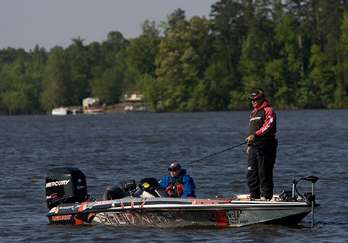
You, the Average Joe weekend angler, are on your way to explore the new frontier. Today, you will embark on an angling foray to fish for the first time on a strange body of water.
What to do? Where to start?
Those are the most obvious questions you will be asking yourself as you cruise down the road, boat in tow.
Fishing new water can be a perplexing experience for the average angler, whose weekend time is balanced precariously at times between obligations on the land and how to squeeze enough time into a fishing trip.
This weekend, you are not alone. Twelve of bass fishing's most talented anglers launched their boats on a new lake for the very first time. No pre-fishing, pouring over maps and reviewing past creel surveys and tournament reports. The setting is Lake Townsend, a 1,500-acre, North Carolina sportfishery where one of them will sack the $250,000 first-place prize in the Bassmaster American presented by Advance Auto Parts.
Before they launched, ESPNOutdoors.com caught up with them and asked the following question: If you were the Average Joe launching on this or any body of water, where would you begin?
John Murray
"This time of year I go by water level, because it sets the bar on how much available shoreline cover you'll have access to. When the water is high, as it can be in spring, I would first look for shoreline cover since there will be more than typically normal. And the fish will spawn in there, or they will cruise the cover looking for fish fry.
"From there, I'd begin gradually working out deeper. The point is to start shallow and then move deep. In that case, you are looking for a transition zone between the spawning areas and where the fish have moved as they migrate back out to deeper water."
Brian Snowden
"I always look at water temperature first during this time of the year. The water temperature will tell you where the fish are in the spawning cycle.
"I would start in the backs of the creeks to see what the temperature is there. If the water is in the low 70s, then the fish are in the spawning mode. If the temp is higher, then gradually move out toward the secondary and then main lake points.
"Water clarity is another factor to consider. Clarity will dictate the color of the lure you should be using. The dirtier the water, the darker the color pattern you should be using.
"Also, the dirtier the water, the shallower you will find the fish."
Gerald Swindle
"Generally speaking, many of the fish this time of year can be caught at depths of five feet or less. But that's also where you'll find most of the anglers."
"I don't like giving in to pressure like that. So I'll turn on my Lowrance 1240 flasher and run offshore at plane speed and look for breaklines, drops, ditches or literally any type of subtle change in the depth.
"The trouble is worth it. Find a subtle depth change like that and it's usually a key migration route for spawning fish that rarely gets any pressure at all.
"And that's my whole point. Let the pressure happen on the shoreline, let all those other guys pound the shoreline. I'd prefer to be outside a little, finding and catching fish that haven't been hammered with pressure."

